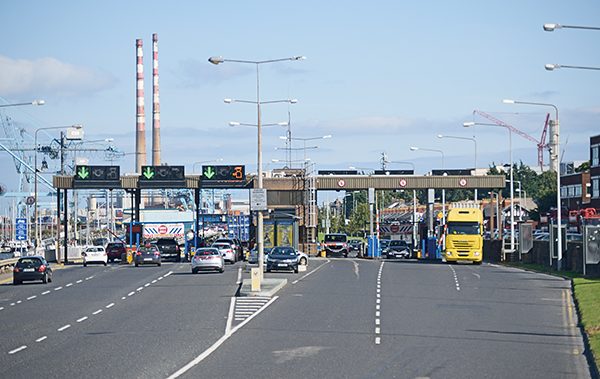
Above: The Toll Plaza.
The East Link road and adjacent lands are a key area for Dublin port, as well as riverside clubs in the area such as Stella Maris, Poolbeg Yacht Club and Small Boat Owners Association.
There has been some boating activity there since at least medieval times. It has a proud seafaring tradition going back to its use as a fishing port. This particular area has housed the clubhouses of Stella Maris and Poolbeg Yacht Club for generations. Indeed the original houses there for the dockers are preserved nearby.
Difficulties and ambiguities surrounding building works in the area have been deeply difficult for residents and have led to much confusion, with the ordinary person unclear as to what is going to happen in this area in the coming years, with little concrete information being released to the public.
The East Link bypass is located at a key juncture in the southside area in terms of the development plans for Dublin 4. Providing access to the coastal route south, Poolbeg peninsula and the new SDZ zone, which has plans for housing development, is one key factor in its strategic location, as well as an area that could be critical for the future of any Eastern Bypass motorway. The area has been mentioned for development in documents such as the National Transport Plan, as well as in council meetings.
Future developments may include the Eastern Bypass Motorway and the Luas extension into the new SDZ area by Sean Moore Road as indicated in the Greater Dublin Area Draft Transport Strategy 2011-2030 document.
Officially, no one will confirm that there are plans for the Eastlink road right now and there is no official current plan that has been published regarding this. DCC and local councillors state that the future plan for the area is still under discussion and that nothing has been decided as yet. Nevertheless, in previous documents there is discussion about this area’s development and it will inevitably come on the agenda.
NewsFour understands that there is a high probability of future development such as a Luas line crossing over from the Point Village and a possible motorway connecting the Port Tunnel with the M50 on the south. This is something that there is a great deal of concern about from groups such as SAMRA as well as boating and rowing organisations by the river.
While most will say that no one knows what is to happen and that the council is keeping plans close to its chest, some things are known through unofficial channels at ground level.
Although the only official part of the area’s development is the East Link wall, a Luas line or motorway connection would come over the Liffey adjacent to the East Link bridge and through the East Link road.
An eastern bypass motorway could feasibly follow through onto Sandymount Strand, although this would mean going through the SDZ recently designated for housing on the IGB site. An alternative to this would a tunnel solution from the Port Tunnel under the Liffey and most likely emerging somewhere on Sandymount Strand and connecting in with the coast road going south.
There will be visible development within the next five years, we understand, beginning with the development of the barrier wall at Stella Maris rowing club which Dublin Port Company is currently overseeing. It is possible that in the next 15 years the clubs located by the East Link may disappear if hyper-development has occurred.
Most organisations by the river in the area are currently applying for grants and there is talk of redevelopment of the clubs. Though many of the exact details are unclear, much of the infrastructure on the East Link road may have to disappear in order to make space for the new widened roads or a Luas track. Certainly, either riverside facilities or actual clubhouses may be moved. In addition to the other side of the East Link by St Patrick’s rowing club being earmarked for development, this would mean a radical change of riverside access and facilities for all clubs concerned on this southern part of the Liffey.
By Kevin Mac Sharry



